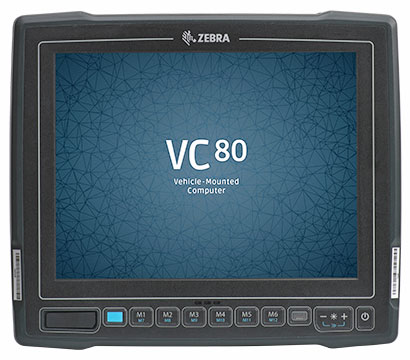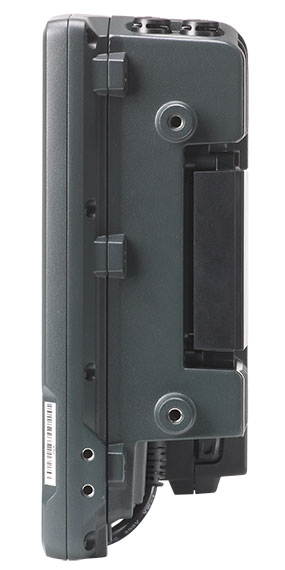|
Zebra VC80x
Ultra-rugged vehicle-mount computer brings Android to mobile material handling applications
(by Conrad H. Blickenstorfer)
The VC80x, introduced by Zebra Technologies) on January 11, 2018, brings the Android operating system platform to material-handling vehicle operations. It is an ultra-rugged vehicle-mounted mobile computer that allows easy Windows to Android migration without changing existing systems or requiring substantial re-training, because the VC80x uses the exact same form factor as the existing and extensively field-proven Windows-based Zebra VC80

First, how does Zebra's new VC80x differ from the company's earlier and still available VC80? Very little, as it is the same box. Only, the VC80 runs Windows and the VC80x Android. Both have the same 10.4-inch touch display, they are the same size and weight, and both are very tough and rugged.
The overall Windows/Android picture
Zebra announced both the VC80x vehicle computer and the MC3300 rugged handheld at the same time in January 2018. Both are new versions of existing products, and both use Android whereas the existing version used Windows. But whereas the MC3300 is a greatly improved Android device that clearly replaces its MC3200 predecessor, the VC80x simply adds an Android version as an alternative to the original VC80. What's the difference?
Android; it's one thing with handhelds...
It's a big difference. That's because for many years rugged and industrial handhelds used Windows CE and Windows Mobile almost exclusively. Even after Android came on the scene, Windows CE and Windows Mobile — eventually renamed Windows Embedded Compact and Windows Embedded Handheld — remained dominant for several more years.
When Microsoft failed to keep its mini operating systems platforms updated, leading manufacturers, including Zebra, began offering Android-based versions alongside. For a while everyone kept hedging their bets because it was assumed that Microsoft would eventually rejuvenate its mobile OS platform.
There was hope when Microsoft billed Windows 10 IoT Mobile Enterprise as Windows Mobile's replacement, but it was too little too late. Towards the end of 2017, Microsoft put Windows Mobile into "maintenance mode," i.e. it was done for. As a result, there was no more need to pursue a dual-OS approach in industrial handhelds, and so Zebra decided to make the MC3300 a fully optimized Android device.
... quite another with larger systems
On the vehicle computer side, things were and are much different. When Zebra introduced the original VC80 the end of 2015, it came with full Windows instead of one of the much more limited compact versions of Windows. That's because the VC80's 10.4-inch screen was big enough for full Windows, it was powerful enough to run full Windows, and since it was plugged into vehicle power, battery life wasn't an issue. Besides, while Android is totally dominant in smartphones (with just Apple having a strong presence in premium phones), Android's position in larger devices isn't nearly as strong, and it's almost completely absent in traditional laptops or desktops where Windows still rules.
So why an Android version of the VC80? Because it makes sense. With Zebra's full commitment to Android on its handheld platforms, why not make it available on vehicle computers as well? Unlike Windows, Android doesn't differentiate between different platforms, and that's a big plus for maintenance, compatibility, and ease-of-use. There was, however, no need to create a replacement product, like the MC3300 is to the MC3200. Windows remains very viable on larger vehicle computers, so the Windows-based VC80 and the new Android-based VC80x can easily coexist.
Now a look at the VC80x
That all said, now let's take a look at the new VC80x. Computing power is provided by the same hexa-core 64-bit Qualcomm 8056 (likely of the Snapdragon 650 variety) as is used in the new MC3300. The Android 7 "Nougat" OS, likewise, is up-to-date. There's 4GB of RAM and 32GB of eMMC mass storage. There doesn't seem to be an external memory card slot.
The VC80x's 10.4-inch resistive touch screen with 4:3 aspect ratio 1024 x 768 pixel XGA resolution is the same as in the Windows-based VC80. And since vehicle-mounts may be deployed indoors or outdoors, Zebra offers both a 400 nits and a 1,000 nits LED backlight option, like in the VC80. There's resistive touch, like in the VC80, and here one might perhaps ask why not capacitive touch as that is what Android was designed for. So no pinching and zooming, but Android still works just fine with resistive touch.
The VC80 measures a compact 10.9 x 9.4 inches and is 3.5 inches thick. It weighs about 8.1 pounds. Both the rear housing and the front bezel are made of cast aluminum for strength and durability.
Given the VC80x's intended application where the panel will be used during vehicle operation, the VC80 design with six direct and six soft programmable keys below the bottom of the display, plus an onscreen keyboard works just fine for Android. If desirable, bottom or side-mounted keyboards are optionally available.
For connectivity, the VC80 has two USB ports (one of them powered), two serial RS232 ports, and a 3.5mm audio jack. Optionally available are an RJ45 LAN jack or a CAN-Bus port with SAE J1939 support. There is a front-facing 87 dBA speaker described as "very loud." Push-To-Talk is available also, and may be used with on optional external speaker/microphone.
The device comes with speedy dual-band 802.11a/b/g/n/ac/k/r WiFi and Bluetooth v4.0. There's an optional external WLAN antenna, if needed. If scanning is needed, Zebra offers their Bluetooth-based LS3478 or DS3578 handheld or RS507 ring-style cordless scanners.
As a vehicle-mounted device, the Zebra VC80x has an internal 12-48 Volt power supply. There's also an internal battery backup to guard against vehicle power issues, or vehicle battery changes.
The VC80x comes with pre-loaded and pre-licensed Ivanti Velocity powered by Wavelink, Workforce Connect PTT Express, as well as DataWedge with SSI scanner support.
The Zebra VC80x is an exceptionally rugged device with IP66 sealing (totally dustproof and can be hosed down with high-pressure water jets), and a wide -22 to 122 degree Fahrenheit operating temperature range. It has also been tested for shock and vibration, humidity, UV, salt fog, and so on.
Zebra says it best
As for its overall positioning, Zebra says it best in their product brochure:
"With the VC80x, you can easily migrate your material handling vehicles to the next generation platform for warehouse mobility. Based on Android, the VC80x delivers a well-proven mobility platform with guaranteed security support you can count on. You can migrate from Windows to Android without changing the experience you have in place today — no re-training, re-configuration, or development is required."
|





